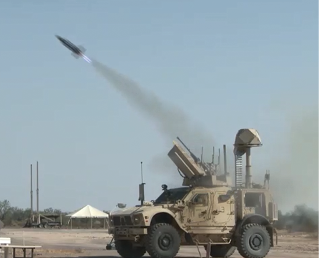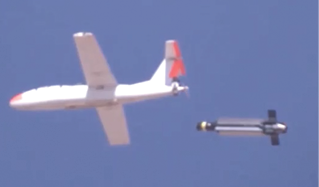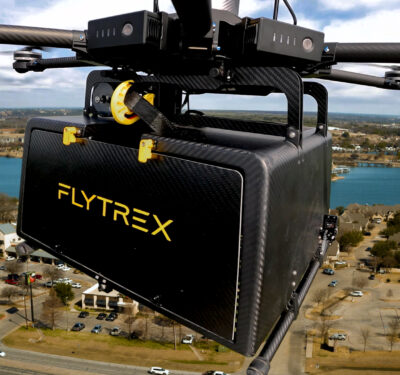Government and vendors alike say when it comes to defeating enemy unmanned aircraft, one size does not fit all.

When discussing military counter-unmanned aircraft systems, one phrase keeps popping up: There’s no silver bullet.
The options for downing an enemy’s small UAS are many—jam them, hijack them, hit them with lasers, knock them down with kinetic UAS—but each option isn’t suitable for every occasion and location. In a sensitive area, such as a city, for example, the military doesn’t want drones falling out of the sky.
“I would tell you the UAS smalls pose a unique and involving threat,” said Lt. Col. Johnathan Hester, the Capabilities Integration Branch chief in the Joint Counter Small Unmanned Aircraft Systems Office (JCO) in the Headquarters of the Army. “So, there’s never one silver bullet. There’s not going to be one capability or one concept that gives you a blanket of coverage. However, the layer defense is an effective, measure to counter small UAS. But as we move forward in developing training and doctrine for counter-small UAS, the concept of layered defense is something that will be an option for commanders based on their location and their situation.”
Of course, the war in Ukraine, which has been dubbed the first drone war, has brought the issue front and center.
“To defeat the overseas small UAS attacks that we’re seeing, the joint warfighters are using a combination of both traditional air defense systems and counter small UAS-specific systems,” Hester told Inside Unmanned Systems. “So, the use of these systems validates…the system of systems approach.”
“The threat is evolving, and Ukraine helps us understand that the threat is evolving,” said Col. Michael Parent, who leads the Rapid Capabilities and Critical Technologies Office (RCCTO) Counter-small Unmanned Aircraft Systems Acquisition and Resources Division. “It helps us to understand and really fix what we are up against. It makes it very real at this point.”
The JCO was established by the U.S. Army in 2021 to serve as the defense-wide tip of the spear for doctrine, requirements, materiel and training to counter current and future small UAS threats, to focus resources on countering the UAS threat while minimizing duplication.
As BAE Systems’ Aimee K. D’Onofrio put it, “They hear industry saying, we got this, we got this, we got this. And they set up a test where they pay for everything and provide the targets and they say, ‘show me.’”
“The bottom line is the services are responsible for the procurement and fielding of solutions,” Parent said. “We conduct these demonstrations to provide them the data. Then if they have a requirement, they can continue to assess and have an operational assessment on their own, which we will support. And then they can determine if it fits their unique service requirement.”
COUNTER UAS UNIVERSITY
JCO is also setting up the Joint Counter Small UAS University at Fort Sill, Oklahoma, scheduled to start initial operations this fall.
“So, in October of this year, the university will open its doors and start training warfighters,” Hester said. “The curriculum considered two courses. One is an operator’s course, the other is a planner’s course. There are currently four training modules on JKO [Joint Knowledge Online, a distributed learning capability] to assist the warfighter with training and understanding countering the small UAS threat,” and a fifth module will be added.
“In FY 25, the Fort Sill Joint Counter Small University will be at full operating capacity, which not only includes the joint warfighter, but also opportunities for our international partners as well.”
At the university, users will be trained on the initial joint solutions and additional ones identified by the JCO. “The operators’ course would focus on providing the joint warfighter the capability not only to efficiently operate, but also employ those approved joint capabilities,” Hester said. “A planner course gives you the ability to have a trained warfighter that is able to not only plan, but also develop concepts in how to employ your counter small UAS capabilities, as well as a concept of layered defense.”

ONE-WAY ATTACK
JCO is continuing to plan demonstrations and engage industry. In June, it will look at the problem of “one-way attack” by larger Group 3-sized drones, or flying munitions that aren’t intended to return.
“We just came off of a demonstration in January,” Parent said. “We looked at one-way attack as well, but from a closer-in range. So, in June we’re going to look at a little bit further range. We’re going to push the envelope a little bit more,” by having them fly high, low and at varying speeds. “We can make it a little bit more challenging for the vendors to come out and really show us what they have and what their capabilities are to get after that threat.”
COMMAND AND CONTROL

Northrop Grumman’s Forward Area Air Defense Command and Control System, or FAAD C2, was selected as the interim command and control system for future counter UAS systems in 2020.
Josh Smith, the company’s technical fellow and chief engineer for FAAD C2, recently spoke at the Counter UAS Technology Europe conference sponsored by SAE Media Group and said the interest in counter-UAS systems is very high around the world.
“I think because this area of technology is changing so dynamically, everybody’s interested in what everybody else is doing,” he told Inside Unmanned Systems. “As you might imagine, there’s a lot of overlap in some of the technology. And, I think there’s a genuine curiosity, especially amongst the government procurement groups, on which systems are actually the best at what they do.”
Four or five briefings at the show had the same mention that there’s no silver bullet, with pictures of bullets or a werewolf or “some other thing from fairytale lore,” Smith said with a chuckle. The end result is something right up Northrop Grumman’s alley.
“I think everybody acknowledges that it’s a difficult solution…it’s finding a way to combine all the different things that people are good with, and making them work together, that makes your systems really effective, right?” he said. “So, it really ends up becoming more of a C2 problem.”
FAAD C2 has been around for a few decades in one form or another. “What our bread and butter has been is reinventing ourselves to adapt to emerging threats in the battlefield. Whether that was counter-rocket, artillery mortar in the 2006-ish timeframe, and now to counter UAS, we’re very much in the business of gathering as many different sensors and effectors as possible.
“As you can imagine, the different sensors kind of all operate in their environments a little bit differently. We strive to detect things as far off as possible. I think what we’ve found is the slowest thing in the defeat chain is generally the operator,” who must decide quickly what sort of effector to use. One thing the company is moving toward is incorporating artificial intelligence to speed up that defeat chain “but still maintaining our commitment to safety.”

THE BUSINESS END
There are several types of effectors in use with counter drone systems. Here’s a look at two very different types.
BAE Systems has been adapting precision-guided kits to existing 70mm rockets to create the Advanced Precision Kill Weapon Systems, or APKWS. The system has proven effective against Group 2 and 3 drones.
“We feel this is a problem that needs to be served through the leverage of economics,” said Greg Procopio, product line director for the company’s precision guidance business. “The current systems are just too expensive and the beauty or benefit of our APKWS system has been able to adopt something that’s affordable, so you can solve this problem of volume and swarming that a UAS system presents. In the recent testing, we’ve had 100% success against engaging Class 2 and 3 UAS.”
The APKWS is an “unguided Hydra rocket, and we basically came along and put in a guidance section, and I like to call it putting a brain in the scarecrow,” said D’Onofrio, portfolio director for APKWS. “So, we took kind of a dumb rocket and make it a smart rocket, very cost effectively, very high precision.” The system uses a laser to paint the target and the APKWS gets close enough and detonates its warhead, destroying the enemy drone.
The company has been working with JCO on demonstrations and will be taking part in the one-way attack demonstration in June.
Blowing up drones doesn’t work in all locations. That’s where effectors such as D-Fend Solutions’ EnforceAir, which can take over rogue or enemy drones, comes into play.
As the company’s motto says, “control the drone to control the threat.”
Kinetic effectors do the job, “but in a sensitive environment, an urban environment, a civilian environment, or even military environments when you’re concerned about friendly fire and things like that, you may want a more controlled outcome,” said Jeffrey Starr, D-Fend Solution’s chief marketing officer.
D-Fend’s system is part of the layered effects under SAIC’s counter-drone system, one of three that have been recommended by the JCO as potential “counter UAS as a service” options for commanders.
“There are many end users who use this as the standalone, go-to tool,” Starr said. “But in terms of defense and larger events and things like that, I think there will always be a layer defense. I don’t think any one vendor claims to be the end-all for everything.”






